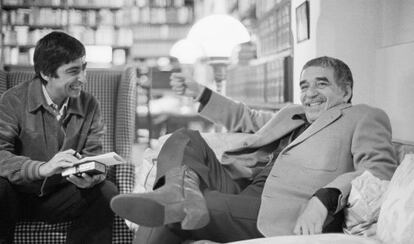“We arrived in Mexico City as a purple sunset settled”
Snippets from the life of Gabriel García Márquez in his adopted country The rush, the splendor, kids kicking balls against his door and a glass of champagne


– Have you read any of García Márquez’s work?
– Yes, One Hundred Years of Solitude and The Whores of My General.
– The Whores of My General?
Antonio Reyes, a 75-year-old man in a white jacket and black bow tie has been working in the distinguished restaurant Bellinghausen in Mexico City for half a century. He isn’t sure about the second title.
What impressed him the most about García Márquez was how attentive he was with his wife, Mercedes Barcha
– Isn’t it No One Writes to the Colonel?
– Yes! - And Antonio Reyes laughs at his own confusion mixing up the whores from another novel by the Colombian Nobel Laureate, Memories of My Melancholy Whores.
García Márquez would go eat there sometimes. The waiter Rafael Arce said he was not one of those clients “who was in a hurry and speaking loudly and wanting to impose his will.” He was “passive, amiable, a gentleman.” He said the writer “shared his opinions calmly.” What impressed him the most about García Márquez was how attentive he was with his wife, Mercedes Barcha. In some ways, Arce is the literary complement of Antonio Reyes. He has not read One Hundred Years of Solitude or No One Writes to the Colonel but he has read Memories of My Melancholy Whores. He read it when his daughter had to study it for school.
“We arrived in Mexico City as a purple sunset settled”
García Márquez wrote in 1983.
His sons and a friend were kicking a ball against the door of his house and Gabo came out, angry. “You little assholes, don’t be so loud, damn it.”
When he started writing ‘One Hundred Years of Solitude’ he bet it all on the book”
It had been 22 years since his arrival in Mexico. He had arrived on Sunday, July 2,1961, the same day one of his favorite writers, Ernest Hemingway, shot himself in the head in Ketchum, Idaho. García Márquez published the first piece he wrote in México the next Sunday in the Mexican cultural review, Revista. It was an obituary of Hemingway titled “A Man Died of Natural Causes". “The 72-year-old writer who was hospitalized twice last Spring due to an old man’s disease, was found dead in his room, his head shattered by a tiger hunting shotgun,” the Colombian wrote about the passing of the man who died of natural causes.
He wrote One Hundred Years of Solitude in Mexico in a house at 19 La Palma Street in the neighborhood of San Ángel.
They are painting the front of the house across the street. The voice of an old man booms out from behind the large gate.
– Yes, I knew him, he says, his eyes betraying his bad mood.
– That house across the street was his, right?
– Yes, and he owed a year on it.
He also liked his dancing style and his way of entering the room, “a little proud, pulled back, never stooping”
– Why was that?
– He said he did not receive the royalties from New York and Buenos Aires.
Oh, how we have changed together, the city and us, since we arrived without a name and without a cent in our pockets on that July 2, 1961 at that dusty railroad station.
García Márquez wrote in 1983.
Then the son came out and said what his father wanted to say was that sometimes the writer could not pay the rent for a month or two at the most and that at the end he would pay. In those days, in 1966 and 1967, the neighbor was crafting his masterpiece and his wife was taking care of the basic needs. “When he started writing One Hundred Years of Solitude he bet it all on the book and Mercedes was the heroine who figured out how - God knows how - to put food on the table,” an old friend from Mexico City said.
The man who came out of the house to clear up the details about the debts the genius from Aracataca owed is Gabriel Pérez del Peral. He says that when he was a child he would play soccer with the writer’s sons, Rodrigo y Gonzalo. They would go out into the street. One of them would send off the corner from one side and the other would kick it against the metal gate of the rented home the García Márquez.
Boom!
Against the door while Gabriel García Márquez was writing One Hundred Years of Solitude.
In a volley.
“He would come out angry and he would say ‘you little assholes don’t be so loud. Damn it, I’m writing,” remembers the childhood friend of the García Márquez children. He remembers the writer in a blue tartan bathrobe and smoking a pipe. Or, in a loose-fitting corduroy jacket, jeans and suede shoes. He remembers seeing Carmen Balcells, Carlos Fuentes and the always elegant Álvaro Mutis in a red Falcon. “He wrote all day,” Gabriel Pérez del Peral says. Pérez del Peral admits he did not understand what was going on with this man who was locked up in a room all day. “I would tell Rodrigo, ‘Hey, your dad doesn’t work, right?’ And Rodrigo would tell me, ‘No, he is writing a book called One Hundred Years of Solitude’.” Sometimes Gabriel would eat at his friends’ house and they would give him a gansito for dessert - a cream and jam-filled chocolate cake. He says that it is delicious to eat fresh out of the fridge, especially with a glass of milk. The neighborhood is calm and quiet enough to wear a bathrobe, smoke a few pipes and invent José Arcadio Buendía.
Another man who visited 19 La Palma Street was Jacobo Zabludovsky. He was on vacation in Miami this week but he took a phone call to talk about his friend. Zabludovsky believes that it was 20 years after One Hundred Years of Solitude had been published that he was entrusted with putting up a plaque at the front of the house to commemorate the fact that the most well-known Spanish-language book of the 20th century had been written there. “We pulled up the piece of cloth to unveil the plaque and we were thrilled. The next day it was stolen.” Zabludovsky suspects the thieves stole it in order to melt and sell the bronze.
His old neighborhood was calm and quiet enough for him to wear a bathrobe, smoke a few pipes and invent José Arcadio Buendía.
Many years later, when García Márquez had been living at this final home in Fuego Street, where he had a bougainvillea tree he loved and a beautiful magnolia, Zabludovsky was one of the friends who would join him at the piano bar of the cultural building, Polyforum. The journalist said the Nobel Prize winner liked to drink “a little glass of champagne.” The owner of the bar, Magdalena Rodríguez, says that when he began to frequent her business around 2000, he would drink Glenfiddich whisky. He took up champagne some time later. He always ordered fish, sometimes a medium rare tuna. He liked vanilla ice cream for dessert. Magdalena Rodríguez met García Márquez and Mercedes Barcha on a Sunday at 6pm in a restaurant in the south of the city. She approached him and thanked him. The writer asked him why. “For the Cholera, The Colonel and The Solitude,” she said. He invited her to sit down and they talked for a while.
Magdalena Rodríguez told them that she owned a bar.
Four days later, on a Wednesday at midnight, Gabriel García appeared at the door. He was with the Colombian journalist Roberto Pombo and both their wives. At the end of that surprising evening, when her idol had left, Magdalena Rodríguez was left with a nervous sensation and “a great deal of gratitude to God for having had the opportunity to listen to him.” Later, they would become friends. That night she heard him talk about Pablo Neruda.
There were caricatures of the famous by the Mexican artist Luis Carreño on the walls of the bar. Carreño, who painted the writer on various occasions, says García Márquez’s face was filled with triangles.
The mustache.
The eyebrows.
He also liked his dancing style and his way of entering the room, “a little proud, pulled back, never stooping.” Carreño remembers that some would try to film him at the bar but he always avoided the cameras. Upon realizing who he was, others would run out to a bookstore and buy two or three books for him to sign.
News arrived in early April that García Márquez was in the hospital in Mexico City, Luis Carreño drew a sketch for the newspaper El Universal. He drew him seated on a couch in the hospital. Everyone was talking about his health at the time. A thought bubble bursts out of the writers’ head. I have not had one moment of solitude.
Translation: Dyane Jean François
Tu suscripción se está usando en otro dispositivo
¿Quieres añadir otro usuario a tu suscripción?
Si continúas leyendo en este dispositivo, no se podrá leer en el otro.
FlechaTu suscripción se está usando en otro dispositivo y solo puedes acceder a EL PAÍS desde un dispositivo a la vez.
Si quieres compartir tu cuenta, cambia tu suscripción a la modalidad Premium, así podrás añadir otro usuario. Cada uno accederá con su propia cuenta de email, lo que os permitirá personalizar vuestra experiencia en EL PAÍS.
¿Tienes una suscripción de empresa? Accede aquí para contratar más cuentas.
En el caso de no saber quién está usando tu cuenta, te recomendamos cambiar tu contraseña aquí.
Si decides continuar compartiendo tu cuenta, este mensaje se mostrará en tu dispositivo y en el de la otra persona que está usando tu cuenta de forma indefinida, afectando a tu experiencia de lectura. Puedes consultar aquí los términos y condiciones de la suscripción digital.
More information
Últimas noticias
Most viewed
- Pablo Escobar’s hippos: A serious environmental problem, 40 years on
- Why we lost the habit of sleeping in two segments and how that changed our sense of time
- Charles Dubouloz, mountaineering star, retires at 36 with a farewell tour inspired by Walter Bonatti
- Reinhard Genzel, Nobel laureate in physics: ‘One-minute videos will never give you the truth’
- The Florida Keys tourist paradise is besieged by immigration agents: ‘We’ve never seen anything like this’









































